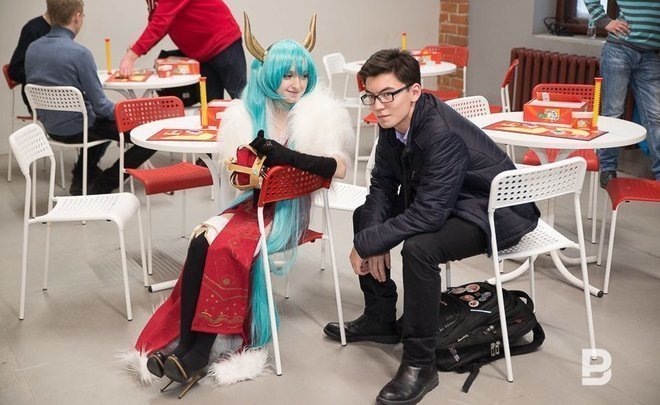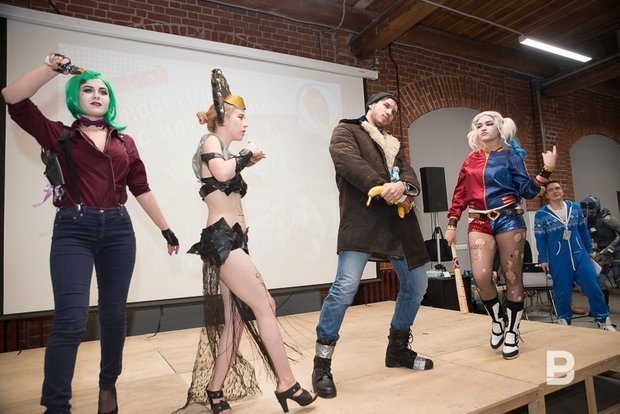‘Muslims also face the interest of young people in anime, and not always peacefully’
An expert — on the influence of Japanese mass culture on Islam

The mass art of Japan has had a great influence on many cultures. Japanese animated series are popular all over the world today, and Russia is no exception. Moreover, not only secular youth has fallen in love with this subculture, it also had influence on Muslim teenagers. On the topic of whether anime and Islam can get along — our columnist, expert of the Centre for Islamic World Studies, Karim Gaynullin, discusses in the author's column for Realnoe Vremya.
Muslims also face the interest of young people in anime
On Thursday, I was invited to a discussion from the Darulfikr website dedicated to traditional Islam. It was dedicated to the influence of Japanese popular culture on the Muslims.
This influence deserves a separate study. It can be strange when people with avatars from popular Japanese animated series meet on Arabic-language portals dedicated to some subtle issues of Islamic theology: scholastic Islamic tradition (qalam) or Islamic law in the deepest aspects. In the Arab Internet, such avatars are also found among critics of Islam — Muslim apostates (murtad).
Russia is no exception here: anime appeared in our country during the Soviet Union.
In the time of perestroika, in my opinion, the perception of what the “culture” of anime should look like was different from the current state. Today, anime is perceived as an integral part of the world mass culture. But in the late 1990s — early 2000s, there was an era of subcultures in Russia, and young people were tightly divided into emo, goth, skinheads, and so on. Among them, there also was the “otaku” subculture, lovers of Japanese animation.
Subcultures somewhat resembled small cults: they listened only to certain music, watched only certain “their” movies and dressed in their own way. “Otaku”, like characters from anime, began to dye their hair blue and pink, wear bright clothes and arrange “anime-cons”, where they gathered to discuss their favourite “titles” (anime series). Today, pink or blue hair is not a marker of belonging to some subculture, a new era has come.
The Muslims also encounter the interest of young people in anime, and this clash is not always peaceful: in Dagestan, for example, anime festivals are traditionally dispersed.

What is anime?
Since the English word animation is unusual for the Japanese ear, the Japanese have shortened it to a convenient “anime”. Thus, for Japan, “anime” is any animated film.
Animated films have appeared in the West, especially in America. During the World War II, Imperial Japan tried to use animation in its propaganda. After the World War II, Japan was greatly influenced by America. It is during this period that the formation of the genre takes place. A big role here was played by Osamu Tezuka, an animator, whose most famous series Astro Boy is a classic of the genre.
Despite that anime at that time was created almost exclusively for children (“kodomo” genre), even then “adult” notes of Japanese animation began to appear. First of all, Astro Boy, unlike the American “Tom and Jerry” or “Woody Woodpecker”, is distinguished by the presence of a single storyline that unites the entire series.
Another reason for the popularity of animation in Japan is the traditionalism of this genre. It is worth saying that anime usually has two main sources of inspiration: visual novels, which are a computer game-novel with a choice of answers for the main character; as well as Japanese manga comics. So, the art of manga for Japan is much more ancient, going back in part to the paintings of Hokusai and the engravings of Japanese Buddhist monks; however, manga also came under the great influence of American comics.
Over time, anime has become overgrown with a large number of subgenres. Along with children's anime — kodomo, which still occupy a significant percentage of the created material (however, almost unknown in the West and in Russia, where anime is primarily interesting not for children, but teenagers), “adult” genres have appeared. Firstly, this is “shonen” — an anime for teenagers about school and relationships. Secondly, this is “shonen” — anime for adults, where the themes of violence are touched upon, with a more complex storyline and references to world culture. Japanese animated pornography also occupies a large niche, which also has its precedents in Japanese culture (you can recall some more prints by Hokusai).
Anime problems from the position of a traditionalist
As a traditional Muslim, I have my own view on anime and the subculture that grew up around Japanese animation. It is worth noting that it would be wrong to generalise all anime — this is a very broad phenomenon of Japanese culture. Therefore, we will talk about the problems inherent in most of the product of Japanese cartoons.
- Eurocentrism Despite that anime is an “Asian”, Japanese product — the founding fathers of the genre were inspired by European animation. In particular, Osamu Tezuka borrowed the use of eyes as a transfer of character and emotions of the character. Therefore, a kind and innocent anime character will most often have big eyes, and an evil and insidious one will have narrow ones.
This is the reason for which anime is most often criticised in Japan itself — an inadequate idea of beauty for a country with 99% of the population with a Mongoloid racial type. As a result, Japanese women are forced to adapt: use very deep makeup, completely changing the natural appearance of girls, as well as go for numerous plastic surgeries. There are also more radical options: special plush costumes with big eyes. - Patriarchy: with its pros and cons The word “patriarchy” under the influence of feminism began to have an exclusively negative connotation. For the opponent of the approach, it is necessary to divide between “negative patriarchy” and “positive patriarchy”.
Anime has a number of signs of “negative patriarchy”. In particular, it, at least in the teen series, deeply “objectifies” a woman who, in most popular Japanese animation, is non-subjective. There are a number of patterns called “dere”, under which a female character should fall: yandere, tsundere, kudere, dandere, etc.
Of course, there are roles in art in general (for example, literary critics distinguish images of “Hamlet”, “Don Quixote”, “Faust”, etc., which have become exemplary for all literary works), but speaking of female patterns in anime, such characters have almost no individual characteristics, they most often differ only in hair colour.
According to my observations, this negatively affects anime fans: they begin to completely imitate their favourite anime patterns, instead of learning meaningful conversation. It is worth adding that almost every one of the images of these patterns can hardly be called psychologically healthy.
The manifestation of “positive patriarchy” can be attributed to that anime tends to glorify a number of male virtues: courage, perseverance, loyalty to friendship, sacrifice, even samurai honour. - Pornographic character Despite that direct pornography usually inhabits certain genres of Japanese animation, eroticism encompasses a significant part of the product — including iconic, legendary works. A person who is tired of treating the body as an object of trade, as well as tired of how modern mass culture constantly sells sexual arousal, is unlikely to like this. But a teenager who is hungry and ready to watch the most absurd product, suffering the complete absence of a plot, in order for the characters to shine naked, will like it completely.
- Pagan background and lack of Abrahamic morality This point is also related to the previous ones. The thing is that Japan and Japanese animation were significantly less influenced by Christianity (which is obvious) than Western animation. Before the sexual revolution of the 1960s and 1970s, restrictions on popular culture were even tougher, and in comparison with today, it seems that everything has become permissible. In fact, some fragments of the Christian understanding of morality exist, and what is unacceptable for modern Marvel films is acceptable for anime and manga.
Another possible problem: in anime magic, the worship of spirits, energy — is not perceived as a fairy tale and is portrayed with all sincerity.
Art: against aesthetics and a return to hermeneutics.
The main reason why I prefer other art forms is the philosophy of animation.
Animation as a form of creativity gives the opportunity to convey the emotional and sensual states of the characters in a form that I do not consider acceptable.
Probably, this is the reason for the popularity of anime — the opportunity to fully immerse the viewer in the emotional state of the character. For animation, there are no restrictions imposed on reality: the eyes can take any state available to the artist, depending on the feelings, the size of the hero and the surrounding reality can change: when angry, it can burn, when sad, it can rain. By the way, it is also very pagan forms — the personification of the element, bringing it to the border of deification. Persephone lives with Hades for six months, and for six months — on Earth, and when she goes to the kingdom of Hades, nature (Demeter) cries, and when she returns, Spring comes.
And here we come back to the question of the value of art. The ancients believed that through myth we can join Wisdom, to comprehend high ideals, we can educate ourselves as a hero and understand the superhuman.
But intellectual effort is necessary for the introduction to Wisdom. This is the purpose of images and strokes that allow us to go beyond formal reality through interpretation. This is the great goal of hermeneutics — to bring the human mind closer to the perception of pure truth.
Therefore, the images of high traditional art are often incomplete and force a person to turn to his own rationality and imagination. In contrast to aesthetic art: here, on the contrary, a complete transfer of states of reality. The viewer's participation in art is minimal: they are essentially amoebas, accepting everything that the author gives them.
Here is the paradox: a prophetic hadith or even an edifying parable from Sufi collections educate a person much more than a product that exerts a huge sensual and aesthetic influence. Because together with the tradition, intellectual work is required to develop understanding: an appeal to multi-volume interpretations, comparison with other traditions and with one's own life.
Therefore, the directors of the “other cinema”, intended for a narrow circle of intellectuals, often use tools from the past: they shoot films in black and white or even mute, or completely without scenery (as in Lars von Trier's Dogville). It is important for them to limit sensory perception and come to pure rationality.
Of course, this is a problem not only of anime, but of mass culture as such. And for sure, there is a Japanese animation devoid of the mentioned curvature. We are talking about a mass product that most fans of the genre are inspired by.
Reference
The author's opinion may not coincide with the position of the editorial board of Realnoe Vremya.